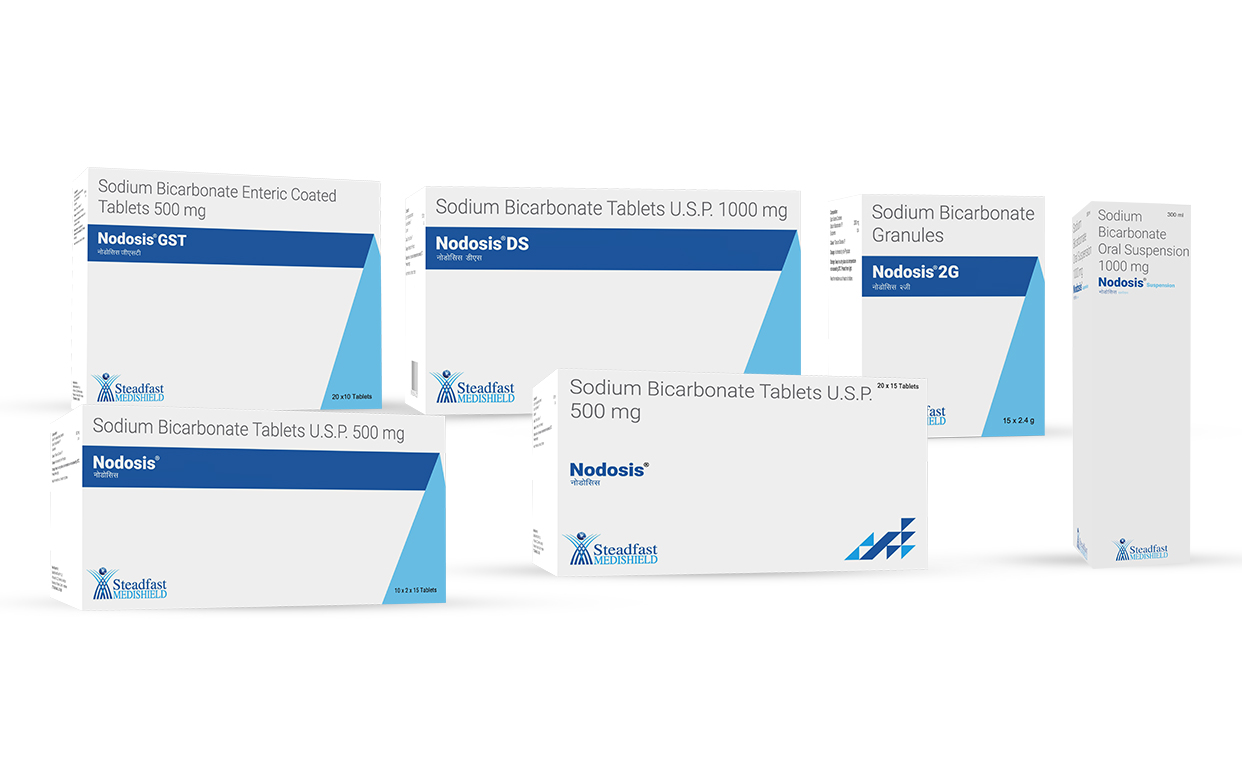
Description
NODOSIS is Sodium Bicarbonate tablets which is used as an alkalinizing agent in the treatment of metabolic acidosis. Sodium bicarbonate also may be used as an alkalinizing agent in advanced cardiovascular life support (ACLS) during cardiopulmonary resuscitation (CPR) and in the treatment of certain intoxications (e.g., methyl alcohol, phenobarbital, salicylates) to decrease renal reabsorption of the drug or to correct acidosis.
Sodium Bicarbonate also is used to increase urinary pH in order to increase the solubility of certain weak acids (e.g., cystine, sulfonamides, uric acid) or in the treatment of hemolytic reactions requiring alkalinization of the urine to diminish the nephrotoxic effects of blood pigments. In addition, the drug is used in the treatment of severe diarrhea accompanied by substantial GI bicarbonate loss and as an adjunct in the treatment of hyperkalemia to induce the cellular uptake of potassium and return the ratio of intracellular to extra cellular potassium concentration toward normal.
Composition
- Each film-coated tablet of NODOSIS contains film coated Sodium Bicarbonate I.P. 500 mg.
- NODOSIS-DS contains film coated Sodium Bicarbonate I.P. 1000 mg.
- NODOSIS Suspension is flavoured syrupy base of 1000 mg of Sodium Bicarbonate in 15 ml.
- NODOSIS-GST contains enteric coated Sodium Bicarbonate 500mg.
- NODOSIS 2G – each sachet contains 2.4g of Sodium Bicarbonate granules. .
Pharmacology
Sodium Bicarbonate (NODOSIS) therapy increases plasma bicarbonate, buffers excess hydrogen ion concentration, raises blood pH and reverses the clinical manifestations of acidosis. Plasma concentration is regulated by the kidney through acidification of the urine when there is a deficit or by alkalinization of the urine when there is an excess. Bicarbonate anion is considered “labile” since at a proper concentration of hydrogen ion (H+) it may be converted to carbonic acid (H2CO3) and hence to its volatile form, carbon dioxide (CO2) excreted by the lung. Normally a ratio of 1:20 (carbonic acid; bicarbonate) is present in the extra cellular fluid. In a healthy adult with normal kidney function, practically all the glomerular filtered bicarbonate ion is reabsorbed; less than 1% is excreted in the urine.
Indications
Sodium Bicarbonate (NODOSIS) is indicated in the treatment of metabolic acidosis; promotion of gastric, systemic, and urinary alkalinization; replacement therapy in severe diarrhea; used to reduce incidence of chemical phlebitis.
Contraindications
Sodium Bicarbonate (NODOSIS) is contraindicated in patients who are losing chloride by vomiting or from continuous gastrointestinal suction and in patients receiving diuretics known to produce a hypochloremic alkalosis, metabolic and respiratory alkalosis; hypocalcemia in which alkalosis may produce tetany, hypertension, convulsions or CHF; when administration of sodium could be clinically detrimental.
Precautions
Sodium Bicarbonate should not be used if you have certain medical conditions. Before using this product, consult your doctor if you have: a certain breathing problem (pulmonary edema), congestive heart failure, severe kidney disease (e.g., inability to make urine), severe liver disease (e.g., ascites, cirrhosis), high sodium levels, and swollen ankles/legs/feet due to retaining water (peripheral edema). If you have any of the following health problems, consult your doctor before using Sodium Bicarbonate: low calcium levels, high blood pressure, heart problems (e.g., irregular heartbeat) and kidney disease.
Because this medication contains salt (sodium), do not use if you are on a salt-restricted diet.
During pregnancy, this medication should be used only when clearly needed. This medication may worsen high blood pressure during pregnancy (toxemia of pregnancy). Discuss the risks and benefits with your doctor.
This medication may pass into breast milk. Consult doctor before breast-feeding.
Side Effects and Adverse Reactions
Some of the side effects although may occur rarely with Sodium Bicarbonate are nausea or vomiting, headache, muscle pain, swelling of feet, ankles or legs, decreased appetite, unusual tiredness, constipation, dry mouth or increased thirst or increased urination.
Some of the common adverse reactions which may occur with Sodium Bicarbonate are Exacerbation of CHF, Rebound hyperacidity, milk-alkali syndrome, Hypernatremia, alkalosis, Extravasations with cellulitis, tissue necrosis, ulceration, venous irritation, tetany or edema.
Dosage and Administration
The dose of Sodium Bicarbonate will be different for different patients. Usual Adult Dose for Moderate metabolic acidosis is 325 to 2000 mg orally 1 to 4 times a day. (Patients younger than 60 yr of age, max dose 16 g/day; patients older than 60 yr of age max dose 8 g/day).
Concomitant Therapy
Sodium Bicarbonate can decrease elimination of amphetamine, dextroamphetamine, ephedrine, flecainide, mecamylamine, methamphetamine, pseudoephedrine and quinidine, thus increasing their therapeutic effects.
Sodium Bicarbonate can increase elimination of Chlorpropamide, lithium, methotrexate, salicylates and tetracyclines, thus decreasing their therapeutic effects.
Overdosage
Sodium Bicarbonate should be stopped in alkalosis, manage the patient according to the degree of alkalosis present. 0.9% sodium chloride injection intravenous may be given; potassium chloride also may be indicated if there is hypokalemia. Severe alkalosis may be accompanied by hyperirritability or tetany and these symptoms may be controlled by calcium gluconate. An acidifying agent such as ammonium chloride may also be indicated in severe alkalosis.
Storage
Store in a cool, dry place. Protect from light and moisture.
Milliequivalence
5.95 mEq of Sodium & Bicarbonate in 500 mg of NODOSIS Tablet, 11.9 mEq of Sodium & Bicarbonate in 1000 mg of NODOSIS-DS Tablet, 11.9 mEq of Sodium & Bicarbonate in 15 ml of NODOSIS Suspension, 5.95 mEq of Sodium & Bicarbonate in 500 mg of NODOSIS-GST Tablet. 23.8 meq in 2.4 g of Sodium & Bicarbonate in Nodosis 2G
Presentation
NODOSIS 15 tablets packed in a strip, 10 such strips in a carton
NODOSIS-2G 2.4 g of powder packed in a sachet, 15 such sachets packed in a carton
NODOSIS-DS 15 tablets packed in a blister, 20 such blisters packed in a carton.
NODOSIS-GST 10 tablets packed in a blister, 20 such blisters packed in a carton
